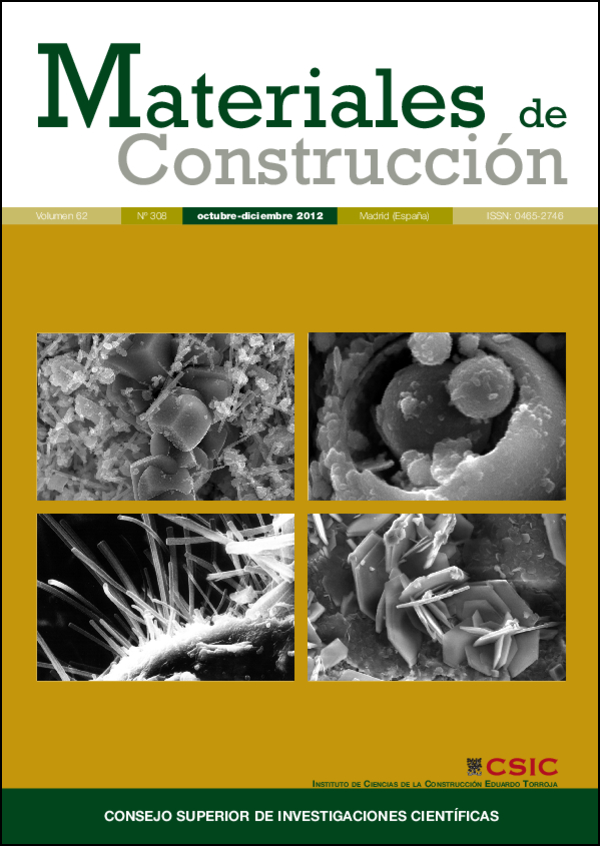Characterization of mudejar mortars from St. Gil Abbot church (Zaragoza, Spain): Investigation of the manufacturing technology of ancient gypsum mortars
DOI:
https://doi.org/10.3989/mc.2012.07311Keywords:
San Gil, Mudejar, Gypsum mortar, Lime, Characterization, Technological procedureAbstract
This work has been focused on the investigation of the technological procedure of Mudejar mortars applied to the characterization of a group of unaltered samples from an example church of Mudejar architecture of Aragon. The research was carried out using multi-analytical techniques including petrographic study, chemistry and mineralogical analysis. All mortars present a homogeneous composition. The binder is made up of a mixture of gypsum and a very low proportion of lime, while the main components of the aggregate are gypsum and carbonate rock fragments, both in a different thermal state of decomposition. The results have proved that both, binder and aggregates display the same composition in these mortars. These aggregates are the by-product of a grinding process of the previously burnt raw materials which have had a positive influence on the properties of the mortars in improving their quality.
Downloads
References
(1) García de Paso, A.: La Iglesia Parroquial de San Gil Abad de Zaragoza. Ed: Institución Fernando el Católico. Zaragoza, (1985).
(2) Borrás, G.: Arte mudéjar aragonés. Eds: Caja de Ahorros y Monte de Piedad de Zaragoza, Aragón y Rioja y Colegio Oficial de Arquitectos Técnicos y Aparejadores de Zaragoza. Zaragoza, (1985).
(3) Igea, J.: Caracterización de los materiales de construcción del Mudéjar aragonés. Diseño de nuevos morteros para su aplicación en restauración. Tesis Doctoral, Universidad de Zaragoza (España), (2011).
(4) Igea, J.; Lapuente, P.; Blanco-Varela, M.T.; Martínez-Ramírez, S.: “Ancient gypsum mortars from Sta. María Magdalena church (Zaragoza, Spain): Advances in technological manufacture”, Proceedings of 2th Historic Mortars Conference edited by J. Válek, C. Groot, J.J. Hughes. Prague, (2010), pp. 197-205.
(5) Alvarez-Galindo, J.I.; Ontiveros, E.: “Morteros. Programa de normalización de estudios previos aplicado a bienes inmuebles”, Junta de Andalucía, Consejería de Cultura e Instituto Andaluz del Patrimonio Histórico (Eds.), Sevilla. PH Cuadernos, vol. 19, (2006), pp. 92-146.
(6) Carò, F.; Di Giulio, A.: “Reliability of textural analysis of ancient plasters and mortars through automated image analysis”, Mater. Charact., vol. 53, nº 2-4, (2004), pp. 243-257. http://dx.doi.org/10.1016/j.matchar.2004.06.014
(7) Elsen, J.: “Microscopy of historic mortars-a review”, Cem. Concr. Res., vol. 36, (2006), pp. 1416-1424 http://dx.doi.org/10.1016/j.cemconres.2005.12.006
(8) Luxán, M.P.; Dorrego, F., Laborde, A.: “Ancient gypsum mortars from St. Engracia (Zaragoza, Spain): Characterization. Identification of additives and treatments”. Cem. Concr. Res., vol. 25, (1995), pp. 1755-1765. http://dx.doi.org/10.1016/0008-8846(95)00171-9
(9) Franzoni, E.; Sandrolini, F., Baldazzi, L.: “Characterization of gypsum-selenite plasters from historic buildings in the Emilia-Romagna region (Italy) 2, Proceedings of 2th Historic Mortars Conference edited by J. Válek, C. Groot, J. J. Hughes. Prague, (2010), pp. 157-164
(10) Igea, J.; Lapuente, P.; Mandado, J.: “Aproximación al Estudio Petrográfico de Áridos Yesíferos en Morteros. Ejemplo de Sta. María de la Huerta, Magallón (Zaragoza)”. Macla, Vol. 9, (2008), pp.133-134.
(11) Bustamante, R.; Sánchez de Rojas, M.I.: “Study of plaster finishes on San Pedro de los Francos church at Calatayud”, Mater. Construcc., Col. 286, (2007), pp. 53-64.
(12) Hughes, J.; Leslie, A.B.: “The petrography of lime inclusions in historic lime based mortars”, Proceedings of 8th Euroseminar on Microscopy Applied to Building Materials. Athens, (2001), pp. 359-364.
(13) Zamba, I.C.; Stamatakis, M.G.; Cooper, F.A.; Themelis, P.G.; Zambas, C.G.: “Characterization of mortars used for the construction of Saithidai Heroon Podium (1st century AD) in ancient Messene, Peloponnesus, Greece”. Mater. Charact., vol. 58, (2007), pp. 1229-1239. doi: 10.1016/j.matchar.2007.07.004. http://dx.doi.org/10.1016/j.matchar.2007.07.004
(14) Gadsden, J.A.: Infrared spectra of minerals and related inorganic compounds, Ed: The Butterworth Group, London, (1975).
(15) Cruz, I. de la; Vázquez, T.; Fernández Peña, O.: “IR spectroscopy of sulphates in clinkers and cements”, Mater. Construcc., vol. 201, (1986), pp. 25-42.
(16) Rampazzi, L.; Bugini, R.: “St. Lorenzo Basilica in Milan: Integral approach to characterisation of historical mortars”, e-preservation science, vol. 3, (2006), pp. 21-26.
(17) Álvarez Galindo, J.I.; Navarro, I.; García Casado, P.J.: “chemical studies of the mortars used in the cathedral of Pamlona (Spain)”, Thermochim. Acta, vol. 365, (2000), pp. 177-187. http://dx.doi.org/10.1016/S0040-6031(00)00624-9
(18) Montoya, C.; Lanas, J.; Arandigoyen, M.; Navarro, I.; García Casado, P.J.; Alvarez, J.I.: “Study of ancient dolomitic mortars of the church of Santa María de Zamarce in Navarra (Spain): comparison with simulated standards”. Thermochim. Acta, 107-122.
(19) Moropoulou, A.; Bakolas, A.; Bisbikou, K.: “Characterization of ancient, byzantine and later historic mortars by thermal and X-ray diffraction techniques”. Thermochim. Acta, vol. 269-270, (1995), pp. 779-795. doi: 10.1016/0040-6031((20) Dorrego, F.; Luxán, M.P.; Sotolongo, R.: “Los trabadillos: Origen, utilización y técnicas de preparación. Actas del II Congreso Nacional de Historia de la Construcción editado por Instituto Juan de Herrera. La Coruña, (1998), pp. 145-150.
(21) Genestar, C.; Pons, C.: “Ancient covering plaster mortars from several convents and Islamic and Gothic palaces in Palma de Mallorca (Spain)”. J Cult Herit, vol. 4, (2003), pp. 291-298. http://dx.doi.org/10.1016/j.culher.2003.02.001
(22) Luxán, M.P.; Dorrego, F.; Sotolongo, R.: “Mortars and treatments in the restoration of the Altarpiece of the High Altar of the Pilar Basilica”, Mater. Construcc., vol. 258, (2000), pp. 27-36.
Downloads
Published
How to Cite
Issue
Section
License
Copyright (c) 2012 Consejo Superior de Investigaciones Científicas (CSIC)

This work is licensed under a Creative Commons Attribution 4.0 International License.
© CSIC. Manuscripts published in both the print and online versions of this journal are the property of the Consejo Superior de Investigaciones Científicas, and quoting this source is a requirement for any partial or full reproduction.
All contents of this electronic edition, except where otherwise noted, are distributed under a Creative Commons Attribution 4.0 International (CC BY 4.0) licence. You may read the basic information and the legal text of the licence. The indication of the CC BY 4.0 licence must be expressly stated in this way when necessary.
Self-archiving in repositories, personal webpages or similar, of any version other than the final version of the work produced by the publisher, is not allowed.
















